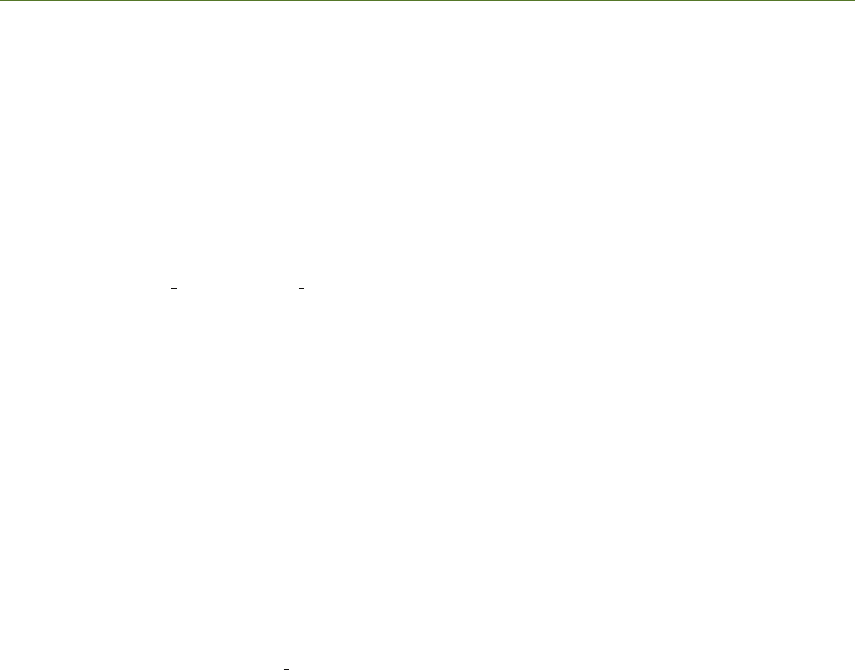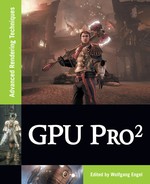
i
i
i
i
i
i
i
i
72 II Rendering
2.4.3 Light Phase
During the light phase both the base and stipple samples within the G-buffer
receive lighting in the same manner as all other values in the G-buffer, adherence
to a common interface allows the fur to receive lighting from a wide range of
sources.
Figure 2.18. Light-accumulation buffer.
2.4.4 Material Phase
The material phase of rendering involves reading the values from the light-
accumulation buffer and interpreting these based on specific qualities of the ma-
terial, in this case by constructing shells of fur. In deferred shading, since the
majority of the lighting values are already correct in the light-accumulation buffer,
a copy of these values is required onto which the material phase of the fur can be
composited (see Figure 2.18).
The stipple values, being distributed on the outermost shell of the fur, will
occlude the layers of fur beneath. To correct this, all fur surfaces must be ren-
dered again using the outermost shell, while sampling color values from the light-
accumulation buffer and depth values from the linear depth stored in the G-buffer
(see Figure 2.19). For most pixels, these color and depth values are written di-
rectly into the composition buffer, however, where a stipple value would be sam-
pled the neighboring pixel is used instead, effectively erasing all stipple values
from the light-accumulation and depth buffers.
The buffer now contains the base mesh of the object only, providing a basis on
which to composite the volumetric layer of fur. Rendering of the fur is performed
by a series of passes, each pass rendering a concentric shell by offsetting the vertex
positions. The pass also constructs positions in screen space, from which both
the sample corresponding to the base mesh and the stipple sample corresponding
to the outermost shell can be obtained.

i
i
i
i
i
i
i
i
2. Implementing Fur Using Deferred Shading 73
Figure 2.19. Stipple obliteration pass.
In the pixel shader these two samples are retrieved from the light-accumulation
buffer, their respective linear depths in the G-buffer are also sampled to compare
against the depth of the sample coordinates and thus correct for occlusion errors.
If both samples are valid, the maximum of the two is chosen to allow for the halo
effect of scattering around the edges of the object without darkening edges where
there is no back lighting. The contribution of the albedo map to the accumulated
light values is removed by division and then reapplied as a linear interpolation
of the base and top albedo maps to account for ambient occlusion by the fur.
The heightfield for the fur volume is sampled at a high frequency by applying
an arbitrary scale to the mesh UVs in the material. The smoothstep function is
used to fade out pixels in the current shell as the interpolation factor equals and
exceeds the values stored in the heightfield, thus individual strands of fur fade
out at different rates, creating the impression of subpixel detail (see Figure 2.20).
Figure 2.20. Shell pass (16 shells).

i
i
i
i
i
i
i
i
74 II Rendering
Figure 2.21. Final image.
2.5 Conclusion
This article has described a series of techniques used to extend the range of
materials that can be presented in a deferred rendering environment, particularly
a combination of these techniques that can be used to render aesthetically pleasing
fur at real-time speeds.
2.6 Acknowledgments
Thanks to everyone at Cohort Studios for showing their support, interest, and enthu-
siasm during the development of this technique, especially Bruce McNeish and Gordon
Bell, without whom there would be no article.
Special thanks to Steve Ions for patiently providing excellent artwork and feedback
while this technique was still very much in development, to Baldur Karlsson and Gordon
McLean for integrating the fur, helping track down the (often humorous) bugs, and
bringing everything to life, and to Shaun Simpson for all the sanity checks.
Bibliography
[Engel 09] W. Engel. “The Light Pre-Pass Renderer.” In ShaderX
7
, pp. 655–666. Hing-
ham, MA: Charles River Media, 2009.
[Green 04] S. Green. “Real-Time Approximations to Sub-Surface Scattering.” In GPU
Gems, pp. 263–278. Reading, MA: Addison Wesley, 2004.
[Hable 09] J. Hable, G. Borshakov, and J. Heil. “Fast Skin Shading.” In ShaderX
7
, pp.
161–173. Hingham, MA: Charles River Media, 2009.
[Heidrich 98] W. Heidrich and Hans-Peter Seidel. “Efficient Rendering of Anisotropic
Surfaces Using Computer Graphics Hardware.” In Proceedings of Image and Multi-
Dimensional Digital Signal Processing Workshop,Washington, DC: IEEE, 1998.

i
i
i
i
i
i
i
i
2. Implementing Fur Using Deferred Shading 75
[Kircher 09] S. Kircher and A Lawrance. “Inferred Lighting: Fast Dynamic Lighting
and Shadows for Opaque and Translucent Objects.” In Proceedings of the 2009
ACM SIGGRAPH Symposium on Video Games, Sandbox ’09, pp. 39–45. New
York: ACM, 2009.
[Lengyel 01] J. Lengyel, E. Praun, A. Finkelstein, and H. Hoppe. “Real-Time Fur Over
Arbitrary Surfaces.” In I3D ’01 Proceedings of the 2001 Symposium on Interactive
3D Graphics, pp. 227–232. New York, ACM Press, 2001.
[Mitchell 04] J. Mitchell. “Light Shafts: Rendering Shadows in Participating Media.”
Game Developers Conference, 2004. Availablwe online at http://developer.amd.
com/media/gpu assets/Mitchell LightShafts.pdf.
[Mittring 09] M. Mittring. “A Bit More Deferred - CryEngine3.” Triangle Game Con-
ference, 2009.
[Mulder 98] J. D. Mulder, F. C. A. Groen, and J. J. van Wijk. “Pixel Masks for Screen-
Door Transparency.” In Proceedings of the Conference on Visualization ’98, pp.
351–358. Los Alamitos, CA: IEEE Computer Society Press, 1998.
[Pangerl 09] D. Pangerl. “Deferred Rendering Transparency,” In ShaderX
7
, pp. 217–
224. Hingham, MA: Charles River Media, 2009.
[Patro 07] R. Patro, “Real-Time Approximate Subsurface Scattering,” Available at
http://www.cs.umd.edu/simrob/Documents/sss.pdf, 2007.
[Scheuermann 04] T. Scheuermann, “Hair Rendering and Shading.” Game Developer’s
Conference, 2004.
[Wyatt 07] R. Wyatt, “Custom Shaders and Effects.” Available at http://www.
insomniacgames.com/research dev/, 2007.
[Valient 07] M. Valient. “Deferred Rendering in Killzone 2.” Develop Conference, July
2007.
i
i
i
i
i
i
i
i
..................Content has been hidden....................
You can't read the all page of ebook, please click here login for view all page.
